Related Research Articles
Philip of Swabia was a member of the House of Hohenstaufen and King of Germany from 1198 until his assassination.

Lotharingia was a short-lived medieval successor kingdom of the Carolingian Empire. It comprised present-day Lorraine (France), Luxembourg, Saarland (Germany), Netherlands, and the eastern half of Belgium, along with parts of today's North Rhine-Westphalia (Germany), Rhineland-Palatinate (Germany) and Nord (France). It was named after King Lothair II, who received this territory after the Kingdom of Middle Francia of his father, Lothair I, had been divided among his three sons in 855.
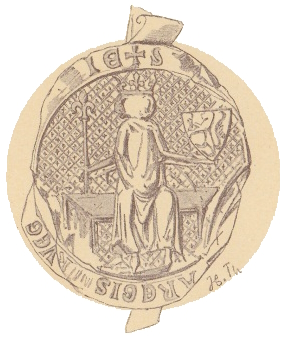
Haakon VI of Norway, also known as Håkan Magnusson, was King of Norway from 1343 until his death and King of Sweden between 1362 and 1364. He is sometimes known as Haakon Magnusson the Younger to distinguish him from his great-grandfather, Haakon V.
An elective monarchy is a monarchy ruled by an elected monarch, in contrast to a hereditary monarchy in which the office is automatically passed down as a family inheritance. The manner of election, the nature of candidate qualifications, and the electors vary from case to case. Historically, it was common for elective monarchies to transform into hereditary ones over time or for hereditary ones to acquire at least occasional elective aspects.
Cao Fang (232–274), courtesy name Lanqing, was the third emperor of the state of Cao Wei during the Three Kingdoms period. He was an adopted son of Cao Rui, the second ruler of Wei. Cao Fang ruled from January 239 to October 254 as a nominal emperor before he was deposed by the regent Sima Shi, after which he became known as the "Prince of Qi". After the fall of Wei in February 266, Cao Fang was conferred the title of "Duke of Shaoling" by Emperor Wu of the Jin dynasty. When he died in 274, he was granted the posthumous name "Li", so his full posthumous title became "Duke Li of Shaoling".

Jaromír, a member of the Přemyslid dynasty, was Duke of Bohemia in 1003, from 1004 to 1012, and again from 1034 to 1035.
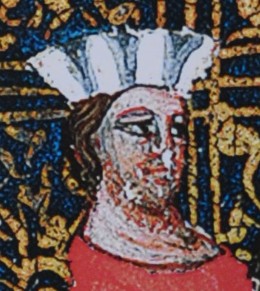
Oldřich, a member of the Přemyslid dynasty, was Duke of Bohemia from 1012 to 1033 and briefly again in 1034. His accession to the Bohemian throne marked the start of a phase of stability after a long period of internal dynastic struggles. Under his rule, the Moravian lands were reconquered from Polish occupation.
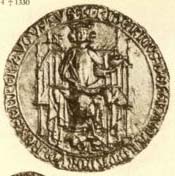
Frederick the Fair or the Handsome, from the House of Habsburg, was the duke of Austria and Styria from 1308 as well as the anti-king of Germany from 1314 until 1325 and then co-king until his death.

Polabian Slavs, also known as Elbe Slavs, is a collective term applied to a number of Lechitic tribes who lived scattered along the Elbe river in what is today eastern Germany. The approximate territory stretched from the Baltic Sea in the north, the Saale and the Limes Saxoniae in the west, the Ore Mountains and the Western Sudetes in the south, and Poland in the east.
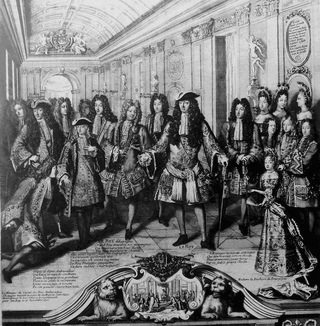
A war of succession is a war prompted by a succession crisis in which two or more individuals claim the right of successor to a deceased or deposed monarch. The rivals are typically supported by factions within the royal court. Foreign powers sometimes intervene, allying themselves with a faction. This may widen the war into one between those powers.

The Veleti, also known as Veletians, Wilzi, Wielzians, and Wiltzes, were a group of medieval Lechitic tribes within the territory of Western Pomerania, related to Polabian Slavs. They had formed together the Confederation of the Veleti, also known as the Union of the Veleti, a loose monarchic confederation of the tribes. Said state existed between the 6th and 10th centuries, after which, it was succeeded by the Lutician Federation.

The Duchy of Saxe-Lauenburg, was a reichsfrei duchy that existed from 1296 to 1803 and again from 1814 to 1876 in the extreme southeast region of what is now Schleswig-Holstein. Its territorial center was in the modern district of Herzogtum Lauenburg and originally its eponymous capital was Lauenburg upon Elbe, though in 1619 the capital moved to Ratzeburg.
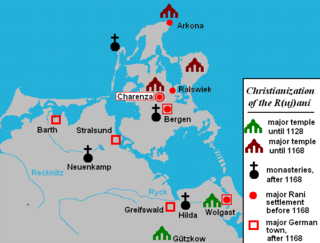
The Rani or Rujani were a West Slavic tribe based on the island of Rugia (Rügen) and the southwestern mainland across the Strelasund in what is today northeastern Germany.

The Silesian Piasts were the elder of four lines of the Polish Piast dynasty beginning with Władysław II the Exile (1105–1159), eldest son of Duke Bolesław III of Poland. By Bolesław's testament, Władysław was granted Silesia as his hereditary province and also the Lesser Polish Seniorate Province at Kraków according to the principle of agnatic seniority.

Pomerania during the Early Middle Ages covers the History of Pomerania from the 7th to the 11th centuries.

The period of rule by the Piast dynasty between the 10th and 14th centuries is the first major stage of the history of the Polish state. The dynasty was founded by a series of dukes listed by the chronicler Gall Anonymous in the early 12th century: Siemowit, Lestek and Siemomysł. It was Mieszko I, the son of Siemomysł, who is now considered the proper founder of the Polish state at about 960 AD. The ruling house then remained in power in the Polish lands until 1370. Mieszko converted to Christianity of the Western Latin Rite in an event known as the Baptism of Poland in 966, which established a major cultural boundary in Europe based on religion. He also completed a unification of the Lechitic tribal lands that was fundamental to the existence of the new country of Poland.

The Lutici or Liutizi were a federation of West Slavic Polabian tribes, who between the 10th and 12th centuries lived in what is now northeastern Germany. Four tribes made up the core of the federation: the Redarians, Circipanians (Circipani), Kessinians and Tollensians (Tholenzi). At least in part, the Lutici were a continuation of the Veleti. In contrast to the former and the neighboring peoples, the Lutici were not led by a Christian monarch or duke, rather power was asserted through consensus formed in central assemblies of the social elites, and the Lutici worshipped nature and several deities. The political and religious center was Radgosc.
The Yemeni Hamdanids was a series of three families descended from the Arab Banū Hamdān tribe, who ruled in northern Yemen between 1099 and 1174. They were expelled from power when the Ayyubids conquered Yemen in 1174. They were a Shia Ismaili dynasty that followed the Fatimid Caliphs based in Egypt. They were also Hafizi Ismaili as opposed to the Taiyabi Ismaili.
Liub, also known as Lub, was a grand prince of the Confederation of the Veleti, rulling from 810 to 823. He was the eldest son, and successor, of Dragovit. He had two sons, Milegast, and Cealadragus, with Milegast, as the eldest son, succeeding his throne.
Milegast was a prince of the Confederation of the Veleti, ruling in 823. He was the eldest son, and successor, of Liub. In 823, he was deposed in an uprising, and replaced with his younger brother, Cealadragus.
References
- 1 2 Słownik starożytności słowiańskich, vol. 3, part 1, Wrocław, 1967. (in Polish)
- 1 2 Jerzy Strzelczyk, Po tamtej stronie Odry. Dzieje i upadek Słowian połabskich. Warsaw: Ksia̜żka i wiedza, 1968, p. 58. (in Polish)
- 1 2 3 Christian Hanewinkel: Die politische Bedeutung der Elbslawen im Hinblick auf die Herrschaftsveränderungen im ostfränkischen Reich und in Sachsen von 887–936. Politische Skizzen zu den östlichen Nachbarn im 9. und 10. Jahrhundert . Münster, 2004, p. 64f. (in German)
- 1 2 Kazimierz Wachowski, Gerard Labuda: Słowiańszczyzna zachodnia. Poznań: Wydawnictwo Poznańskiego Towarzystwa Przyjaciól Nauk, 2000, p. 67. ISBN 9788370632717. (in Polish)
- ↑ Paval Urban: Staražytnyja lićviny: mova, pachodžańnie, etničnaja prynaliežnaść. Miensk, 2001. p. 47. (in Belarusian)